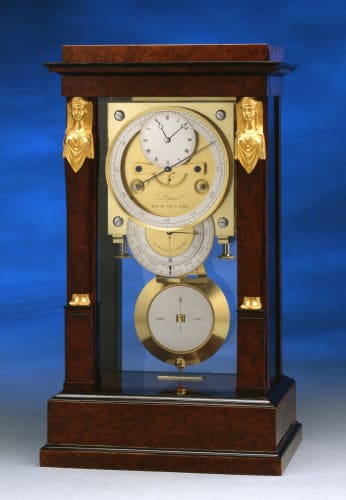Jean-Antoine Lépine combined perfect technical quality with aesthetic design. He was appointed clockmaker to Louis XV and Louis XVI, for whom he made 20 clocks. His firm also made clocks for Napoleon, one of which is in the Palais de Compiegne, while another for the Empress Josephine is in the Mobilier National, Paris. Lépine was also patronised by the Spanish and English royality, three Lépine mantel clocks and an astrological clock are housed at Buckingham Palace, London. In addition, Lépine time pieces can be found in the Victoria and Albert Museum and the Guildhall, London; the Fitzwilliam Museum, Cambridge; the Carnegie Museum; the National Museum of Stockholm; Basel Museum; Mathematische Physikalische Salon, Dresden and Geneva Horological School.
The son of Jean Lépine, a mechanic who made music boxes for Louis XVI, Jean-Antoine was born in Gex, France. He served an apprenticeship under Decrose of Grand Sacconex, Switzerland. By 1744 Lépine was established in Paris, working for Andre Charles Caron (1697-1775). In 1756 he married Caron's daughter and was promptly made a partner. The firm of Caron et Lépine at Rue St.Denis continued until 1769, when Lépine succeeded the elder. During the 1770's he also acted as an agent for Voltaire's workshops at Ferney, near Geneva. In 1772 Lépine transferred his Parisian business to Place Dauphine, by 1778 he was operating from Quai de l'Horloge and from 1781-87 at Rue aux Fosses. He was joined by his son in law, Claude Pierre Raguet (1753-1810), who took over the business, 1783. In 1810 the firm was sold to J. B. Chapuy, who among others employed Jacques Lépine (nephew of Jean-Antoine). The firm continued to prosper under various owner, trading under the name of its founder until 1916.
The development of watch and clock making is indebted to Lépine's technical innovations, his most notable, circa 1760 was the Lépine calibre which resulted in the production of the first genuinely thin watch. The Lépine calibre was soon accepted and developed by other French watchmakers, notably A. L. Breguet (1747-1823). However it was not adopted in England, so while the demand for "thin" watches increased, French watchmakers soon established a pre-eminence. The Lépine calibre is now a universal movement in all watches. Lépine continued to perfect the internal design of his "thin" watches so that parts were more accessible for repair and maintenance. These watches were highly prized, in 1781 he was selling them for £ 840 a piece. Lépine also introduced other innovations such as a watch that wound by a push-piece.
Lépine was also at the forefront of design, and with Breguet was one of the first to use Arabic numerals, for a period he used a combination of both Arabic and Roman figures, but by 1789 his firm had returned to Roman numeration. Lépine developed a unique decoration, surrounding the number 1 with a circle to create an aesthetic balance with the number 11; it appears that he was the only watch and clockmaker to do so The Lépine firm employed some of the finest craftsmen to create fashionable and decorative cases such as Nicolas Petit who created sumptous cases in the Louis XVI style. Thus while Lépine placed emphasis on design he and his firm also aspired toward mechanical excellence.
Copyright by Richard Redding Ltd.
